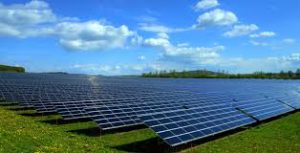Photovoltaik (PV) power plants transform sunlight directly into electricity via the photoelectric effect. Specifically processed materials, such as silicon are necessary for that effect to occur. The materials are doped with other materials for better performance.

Photovoltaic
Dependent on the dopant, the material which is added, the resulting material based on silicon either has an excess (negative, n) or lack (positive, p) of electrons. When joining two differently doped silicon layers, a so-called p-n-junction with an electric field between the two layers forms.
Electrons in a PV-cell absorb the radiation energy from incident sunlight. By means of the electric field between p-n-junction the charge carrier pair is separated into an electron and a hole. The implementation of metal contacts on the PV-cell allows to tap a certain voltage. When connected to a load direct current flows.
As the voltage level of one PV-cell is quite low, several PV-cells are connected in series and form one PV-module. The resulting PV-module features higher voltages. It is protected from external impacts by a layer of glass and a frame made of aluminum.
Electrical power of different modules is tested and compared at standardized conditions. It is denoted at Wattpeak.
Standard conditions for PV test are defined at an irradiance of 1000 W/m², AM = 1.5 and a module temperature of 25 °C. Real-life figures for irradiance can also be higher than 1000 W/m².
The addition “peak” refers to the maximum power the module is able to deliver at standard conditions.
PV-modules fabricated in mass production achieve real efficiencies of almost 20 %. Thinking of about 1000 kWh of solar energy that reaches on square meter, one PV-model with an area of 1 m2 is able to generate a maximum of 200 kWh of electricity per year.
Another important parameter for PV power plants or PV-modules is the utilization or the number of full load hours. In Germany the average PV power plant achieves 800-1000 full load hours per year. In other words: Dependent on the location each kWpeak of installed PV power is able to generate about 800-1000 kWh of electricity in Germany.



